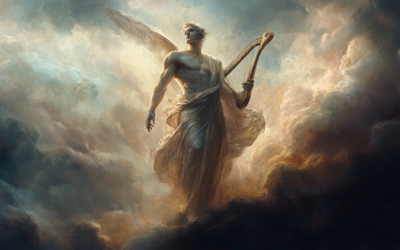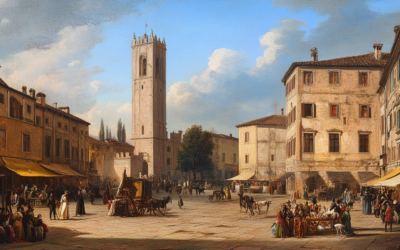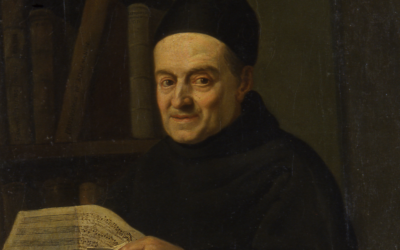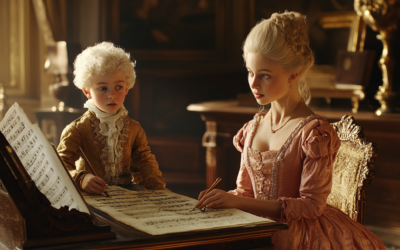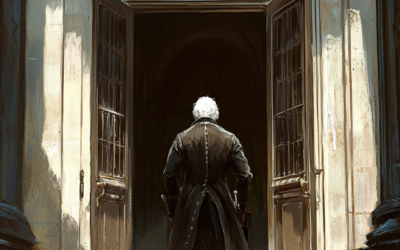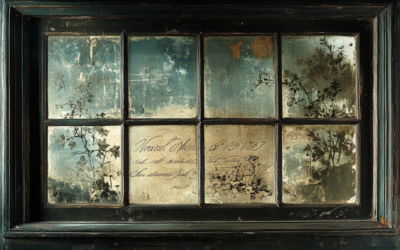The Piano Concertos of 1767
A Genius or a Patchwork?
The genius of Mozart had yet to bloom, despite the anecdotes passed down to us. These concertos were not the work of a prodigy, but a collaborative effort between father and son, built on the music of others.
Mozart: The Fall of the Gods
This book compiles the results of our studies on 18th-century music and Mozart, who has been revered for over two centuries as a deity. We dismantle the baseless cult of Mozart and strip away the clichés that falsely present him as a natural genius, revealing the contradictions in conventional biographies. In this work, divided into two parts, we identify and critically analyze several contradictory points in the vast Mozart bibliography. Each of the nearly 2,000 citations is meticulously sourced, allowing readers to verify the findings. This critical biography of Mozart emerges from these premises, addressing the numerous doubts raised by researchers.
"These concertos were not the work of a prodigy, but a collaborative effort between father and son, built on the music of others."
Mozart: The Fall of the Gods
In the collective imagination, supported by decades of musicological research, certain myths are hard to dispel. One such persistent belief is that of Mozart as a genius and child prodigy, composing piano concertos at an incredibly young age. A popular anecdote, mistaken by many musicologists for historical fact, recounts the story of Mozart’s first attempts to write a piano concerto. Finding it too difficult to perform, he could barely play it himself and had to settle for giving only a vague idea of it on the harpsichord:
One day, as Leopold returned from church with a friend, he found his son busy writing. “What are you doing, my dear?” he asked. “I’m composing a concerto for the harpsichord, and I’ve almost finished the first part,” Wolfgang replied. “Let’s see this scribble,” Leopold said, taking the paper. The two friends laughed at the chaotic mess of notes that were barely decipherable under the ink smudges. But upon closer inspection, Leopold remarked, “Your composition is according to the rules, but it’s unplayable. Who could possibly perform it?” “But it’s a concerto,” the young Mozart protested, “and one must practice until it can be played well.” He then sat at the harpsichord and played just enough to show what he had in mind.
This charming story, passed down through Schlichtegroll and embellished by countless sources, has been accepted as fact. Meanwhile, Leopold’s catalogue, as updated by Constanze’s second husband, Nissen, included four piano concertos allegedly composed by Wolfgang in 1767. These manuscripts, preserved by the publisher André, were believed to be authentic. Thus, the anecdote solidified the image of the boy prodigy, capable at just eleven years old of writing complex piano and orchestral works. These piano concertos—K.37, K.39, K.40, and K.41—are still performed today as if they were Mozart’s original creations, demonstrating the early precocity of the young composer.
But here lies the deception.
In reality, these concertos are “pasticcio” works—compositions created by stitching together movements from sonatas for solo instrument written by fashionable composers of the time, including Hermann Raupach, Leontzi Honauer, Johann Schobert, Johann Eckard, and C.P.E. Bach. According to musicologist Wolfgang Plath, Leopold’s involvement in these concertos was extensive, if not predominant.
Ludwig von Köchel, who catalogued these works in the Köchel-Verzeichnis, was an eclectic figure, more versed in law, botany, and geology than in music. His 1862 Chronological and Thematic Catalogue of Mozart’s Works, still regarded as reliable by many publishers and record labels, included these concertos under Mozart’s name. But Köchel’s lack of musical training led to several mistakes in the cataloguing process, with these pasticcio concertos slipping through the cracks.
Let’s take a closer look at these concertos, beginning with K.37 in F major:
- The first movement (Allegro) is borrowed from Hermann Raupach’s Sonata No. 5.
- The second movement (Andante) is attributed to either an anonymous composer or Johann Schobert.
- The third movement (Allegro) is taken from Leontzi Honauer’s Sonata No. 3.
Similarly, the other concertos follow this pattern. K.39, K.40, and K.41 are also constructed from movements lifted from various sonatas by Raupach, Honauer, Schobert, Eckard, and C.P.E. Bach, composers well-known during Mozart’s childhood but now almost forgotten. These works were not original creations but were heavily arranged and revised by Leopold, prepared for a planned trip to Vienna.
Leopold’s shrewdness lay in selecting compositions obscure enough that no one in Salzburg would recognise them. These sonatas were taken from German composers who primarily worked abroad, making it easy for Leopold to pass them off as his son’s work. Though Wolfgang’s name appeared on concert posters and programs, the names of Raupach, Schobert, Honauer, and Eckard were nowhere to be found.
Mozart completed these four concertos in about two months—far too short a time to create entirely new works but reasonable for copying or rearranging existing music. Despite this, the myth of Mozart as a precocious genius continued to grow, with stories such as the one recounted above perpetuating his legend. Yet the truth is that these early concertos were little more than skilful adaptations of others’ works, a far cry from the original compositions expected from a prodigy.
You May Also Like
Debunking the Romantic Virtuoso Image
The image of Mozart as a Romantic-era virtuoso is a misleading anachronism, fuelled by 19th-century propaganda. Wolfgang was no transcendental pianist, but a product of an era where music was more galant than heroic.
The Visit to Verona
In Verona, young Wolfgang Mozart impressed the local nobility, but the reality behind the scenes reveals a carefully managed public image, where strategic networking and curated praise played key roles in shaping his growing reputation.
Mozart’s Training
The myth of Mozart’s genius is nothing more than a carefully crafted illusion, propped up by misplaced attributions and romanticised biographies. Behind his so-called brilliance lies the reality of his father’s dominating influence and a lack of formal education.
From London to Vienna
The Mozart family’s journey from London to Vienna was marked by illness, failed opportunities, and the relentless ambition of Leopold Mozart, revealing the pressures and challenges behind the facade of success.
The Ambiguous Legacy of Leopold Mozart
This post explores the multifaceted and often controversial life of Leopold Mozart, providing insight into the complexities and contradictions that defined his career and legacy.
Mozart’s Illusory Triumphs
The story of the young Mozart’s so-called triumphs at the courts of Europe is a tale riddled with embellishments, half-truths, and fabrications—many courtesy of Leopold Mozart himself and those who later sought to mythologize his son. One such example is the visit to Munich on 12 January 1762.


